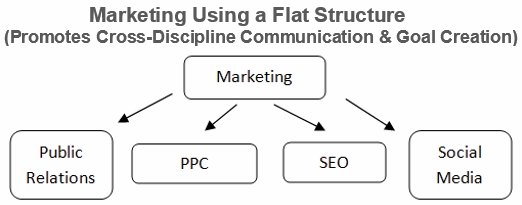Integrated marketing relies on being able to capitalize across channels and disciplines that were once, and often still are, perceived as unique "silos" in the marcom universe: Each discipline can do great work, yet typically mainly serves the goals of that department.
PR and social media are about creating and spreading fame. Driving awareness and positive impressions relies on being top of mind, being present, and being found. And, as each day passes, the importance of ongoing SEO becomes even more critical.
To achieve the greatest publicity—being found and heard from, both online and offline—we have to transition away from the way we think about marketing in general. Having all functions of marketing, from PR to SEO/SEM to social media, working on a planar level increases the power of the keyword strategy.
Here's how marketing used to look:

Strong marketing performance requires coordinating across platforms at a high level:

Why is PR important to SEO, and vice versa?
Outbound marketing, like PR, creates new demand and awareness. Inbound fulfills existing demand. The best "off-page SEO" methods have always just been PR by other names. "Guest posts" are just bylined articles. "Content plus outreach" predates the Web. Asking anyone for links (link building) is essentially a form of PR.
Integrating PR and SEO
In some ways, SEO and PR work together unknowingly.
- High-quality content helps earn links back to a brand's website; links from reputable, credible media sources rank high in Google's algorithm, leading to better search results.
- The more media coverage a brand receives, the more links the brand has leading back to its website.
- As PR pros increasingly work with influencers, the result is more links from blog posts and social media, thus increasing SEO.
That integration between SEO and PR is even stronger when executed in a strategic manner.
PR focuses on messaging and SEO focuses on data, so what's the best way to integrate the two for best results? The following process should always occur concurrently:
1. Align goals across PR, SEO, and all other marketing disciplines
SEO uses digital channels to reach consumers or gain business leads, while PR outreach relies on relationships with the media to generate media coverage of the brand. The strategies to accomplish the goals may be different, but the goal of each department is the same: reach consumers.
2. Use all of the research from both SEO and PR to create an overall persona of the target audience
SEO uses audience research to create personas; PR conducts media research to uncover publications and outlets that reach a brand's target audience and targets reporters that cover topics relevant to the brand. Combine the results of both types of research to create an overall persona.
3. Craft unified messaging documents based on PR and SEO research
PR needs to harness and extend SEO keyword strategy. For example, PR can use multiple variations of predetermined keywords in its press releases and across digital platforms. Using keywords in press releases encourages reporters to use those targeted keywords when describing a brand, thus increasing the likelihood a brand appears in searches for those terms.
Keywords and keyword phrases should appear in overall position statements, press releases (including the title), boilerplates, talking points for media interviews, executive bios, FAQ documents, social media profile bios, website meta titles and descriptions, and website copy.
4. Coordinate content and keywords across all marketing disciplines to ensure the company has a consistent voice across all channels
That includes social media posts, e-books, blog posts, e-newsletters, landing pages, online text, video ads, press releases, media alerts, and media kit documents.
5. Execute
As PR pros are drafting press releases and pitching media outlets, search pros should be using that content to implement SEO, direct link-building, online ads, and other digital work.
6. Analyze and adjust
SEO pros are looking at analytics data, traffic rankings, conversions, sales data, and followings. PR pros are looking at earned media coverage, outlets' publicity value, and outlets' unique visitors per month.
PR can look at SEO's results and determine which media outlets trend to drive the most website traffic and which media outlets tend to send visitors that bounce the least, and determine whether searches for the brand increase after media coverage is secured. From PR's results, SEO can learn best-practices for personal outreach and communication, which can then be used in social media and other customer-centric communications.
* * *
PR and SEO aren't standalone marketing functions. Integrated messaging requires PR and SEO to work together to achieve the best outcomes. Having the full power of PR and SEO under one roof reaches greater audiences and achieves greater goals more efficiently in today's digital business world.




